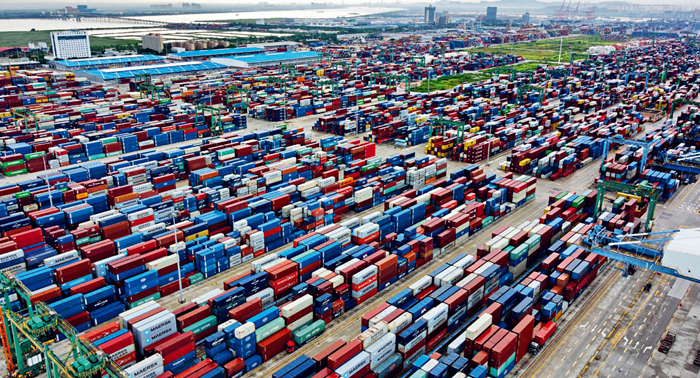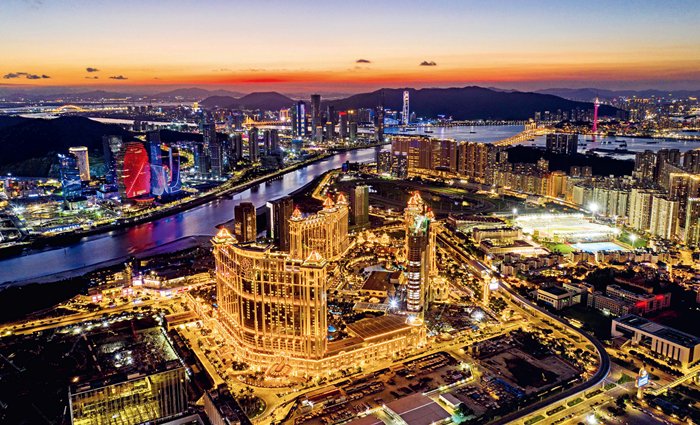|
||||||||||
| Home Nation World Business Opinion Lifestyle ChinAfrica Multimedia Columnists Documents Special Reports |
|
||||||||||
| Home Nation World Business Opinion Lifestyle ChinAfrica Multimedia Columnists Documents Special Reports |
| ChinAfrica |
| Unmatched Resources, Infinite Potential |
| With their respective strengths and advantages, Greater Bay Area cities together make it an unmatched economic cluster |
| By Ehizuelen Michael Mitchell Omoruyi 丨VOL. 14 MAY 2022 ·2022-05-07 |

View of a container yard at the Port of Guangzhou in Guangdong Province on July 17, 2021 (XINHUA)
China’s fastest growing economic cluster - the Guangdong-Hong Kong-Macao Greater Bay Area (GBA) - is a dynamic industrial and technological center of more than 70 million people (100 million expected by 2035) with a total GDP of $2.01 trillion (2021). It has a total area of about 56,000 square km, closely connected by highways, high speed railways and ports.
Being one of the areas with strongest economic vitality and highest openness, the idea of this new and red-hot city cluster in south China was put forward in 2015, as part of the Belt and Road Initiative (BRI). In 2016, it was isolated as a distinct project and included in China’s 13th Five-Year Plan (2016-20). On February 18, 2019, the Chinese Government eventually issued its Outline Development Plan for the Guangdong-Hong Kong-Macao GBA, which intends to guide existing and future developments within an ecosystem integrated both physically and digitally.
As a policy initiative that symbolizes the nation’s broader ambitions to push forward market-oriented reforms, the GBA is aimed at promoting closer cooperation and coordination among the 11 cities in the area, namely, Guangzhou, Shenzhen, Zhuhai, Foshan, Zhongshan, Jiangmen, Dongguan, Huizhou, Zhaoqing, Hong Kong and Macao.
The size of the GBA economy is close to that of Russia and the Republic of Korea, and larger than that of Spain and Australia. As one of the four bay areas in the world with a booming economy, enormous potential, advantageous location and transportation that includes the world’s leading seaports and airports, top popular tourist hubs, favored policies and a pleasant environment, the GBA has significant regional competitive advantages, rivaling global bays such as those of San Francisco, Tokyo and New York, and becoming a global first-class cluster that is comparable to the Silicon Valley.

A night view of Macao on July 31, 2021 (XINHUA)
Industrial diversity
But the true advantage of the GBA rests not in the size or scale. Unlike its competitors which focus on specific sectors, the GBA has almost all key sectors of the modern industrial system, such as automobiles, home appliances, real estate, the internet, and finance. On top of that, it has achieved a balance in its industrial structure development, coupled with the fact that 20 of the world’s top 500 firms are based there.
Therefore, the diversity of industry sectors present in the GBA permits it to compete in multiple sectors on a global level. Hong Kong’s financial position is comparable to New York. Hong Kong has the unique strength as an extraordinary global business and financial hub supported by a robust Basic Law based on legal system which will act as the backbone and bloodline to the growth of the GBA, thereby enhancing the city’s role as a “great connector” by connecting the GBA and the rest of China to the overseas markets and attracting more capital and talents there.
Shenzhen’s high-tech firms and internet firms such as Tencent, DJI, Huawei, and ZTE can gradually develop into strong global players. Apart from that, the city presents an opportunity to leverage its leading role as a special economic zone, a national economic core city and a national innovation city, to expedite its transformation into a modern and international city, and to become a capital of innovation and creativity with global influence.
As for Guangzhou, it presents a significant opportunity to completely leverage the city’s leading function as a national core city and an integrated gateway to strengthen its functions as a worldwide commerce and industry hub and an integrated transport hub. Also, the city presents an enormous opportunity for the auto industry. The appliance industries in Zhuhai and Foshan are competing and pushing their counterparts in Tokyo to move further upstream of the industry.
Macao offers the best tourism and gaming services in the Eastern Hemisphere, not only meeting the entertainment needs within the area, but also attracting capital flows from all of East Asia. Also, economic diversification will be promoted to develop the city into a base for cultural exchange and cooperation.
Undoubtedly, this type of industrial division helps foster deep and frequent cross-integration within the GBA, leading to the birth of more new technologies and products, which, in turn, establishes unique advantages for developing the emerging industries in the future, such as artificial intelligence, intelligent manufacturing, and the Internet of Things.
Broader role
In the longer term, the GBA should be able to act as a catalyst and a vital support pillar for China’s BRI as a whole, where Hong Kong should strengthen its role as a global offshore RMB center and as a dispute settlement center for investment and commercial disputes involving BRI projects. By focusing on the BRI development, the GBA will develop a new system for an open economy, create a high-level platform for China’s opening up, and align with high standard trade and investment rules.
These developments will help enhance the GBA’s worldwide competitiveness and bolster its participation in global cooperation. Located along the coast, at the forefront of China’s opening up with the Pearl River Delta region at its backyard for development, the GBA has the potential to extend its reach beyond the delta region and play a vital role in the BRI, better leveraging the roles and functions of Hong Kong and Macao in the opening up of China, facilitating an effective link between domestic and global markets, and developing an international transport and logistics hub as well as a global cultural exchange hub.
However, in spite of the GBA’s advantages and potential, the plan also faces several challenges. One of the challenges is cross-border flow of capital and data, regional taxation, and regulations on overseas direct investments. Also, the GBA will have to deal with the challenge of regional administrative hurdles.
Since the GBA initiative is a long-term strategic project, the opportunities from BRI and cities like Hong Kong, Macao, Shenzhen, and Guangzhou will ensure these cities’ long-term prosperity and stability, and act as a vital component of China’s efforts to implement the nation’s overall economic strategy of high-quality development, and attain the goals of national rejuvenation and further opening up.
(The author is Executive Director of the Center for Nigerian Studies, Institute of African Studies, Zhejiang Normal University)
| About Us | Contact Us | Advertise with Us | Subscribe |
| Copyright Beijing Review All rights reserved 京ICP备08005356号-5 京公网安备110102005860号 |